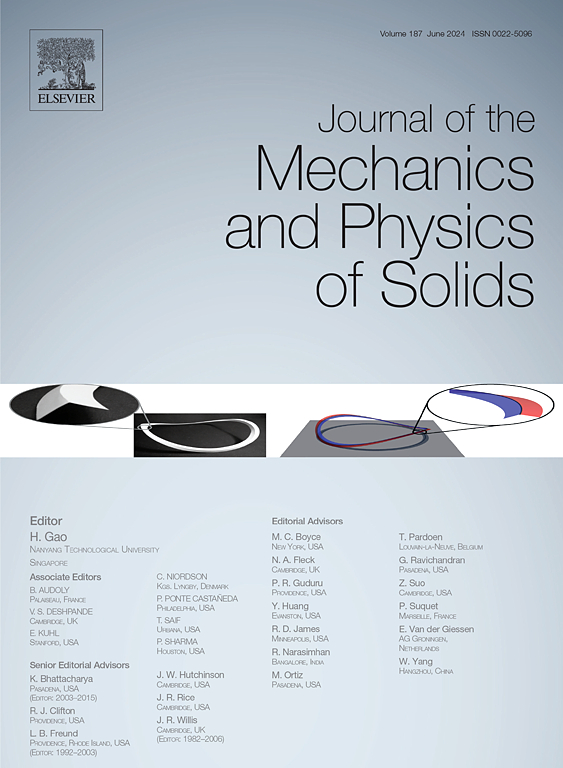Unusual stretching–twisting of liquid crystal elastomer bilayers
IF 5
2区 工程技术
Q2 MATERIALS SCIENCE, MULTIDISCIPLINARY
引用次数: 0
Abstract
Liquid crystal elastomers (LCEs), as a unique class of smart soft materials combining the properties of liquid crystals and hyperelasticity, are capable of rapid, anisotropic, and reversible deformations in response to mechanical, thermal or optical stimuli. Here, we report a hitherto unknown stretching-induced twisting behavior of LCE bilayer strips. Under uniaxial stretching, we reveal that due to the spontaneous mismatch strain arising from interlayer anisotropy, the bilayer strips exhibit notable twisting deformations. We develop an LCE bilayer strip model based on semi-soft elasticity to quantitatively understand and predict such intriguing tension-twisting response. Based on our experiments and theoretical analyses, we systematically explore how the liquid crystal director orientation, geometric dimensions and material parameters of the strips would affect the twisting behavior. We find that when the alignment of directors of bilayer are symmetric about the stretching direction, a larger deviation angle of the initial directors results in a more significant twisting deformation. Additionally, a longer, narrower and thicker strip has a more pronounced twisting effect. Furthermore, the material anisotropy encourages the twisting, while the feature of semi-soft elasticity discourages it. The findings not only reveal the tension-twisting coupling behavior of LCE bilayer strips, but also offer new insights into the design of LCE actuators, intelligent structures and soft robots.

液晶弹性体双层不寻常的拉伸扭曲
液晶弹性体(LCEs)作为一类独特的智能软材料,结合了液晶和超弹性的特性,能够在机械、热或光学刺激下快速、各向异性和可逆变形。在这里,我们报告了一种迄今为止未知的拉伸诱导的LCE双层条带扭曲行为。在单轴拉伸下,我们发现由于层间各向异性引起的自发错配应变,双层条带表现出明显的扭转变形。我们开发了基于半软弹性的LCE双层条带模型,以定量地理解和预测这种有趣的张力-扭转响应。在实验和理论分析的基础上,系统地探讨了液晶定向器的取向、几何尺寸和材料参数对条带扭转行为的影响。我们发现,当双层导向器的对中方向与拉伸方向对称时,初始导向器的偏离角度越大,扭转变形就越明显。此外,更长的、更窄的和更厚的带有更明显的扭转效果。材料的各向异性促进了扭转的发生,而半软弹性的特性则抑制了扭转的发生。研究结果不仅揭示了LCE双层带的张力-扭转耦合行为,而且为LCE致动器、智能结构和软机器人的设计提供了新的见解。
本文章由计算机程序翻译,如有差异,请以英文原文为准。
求助全文
约1分钟内获得全文
求助全文
来源期刊
CiteScore
9.80
自引率
9.40%
发文量
276
审稿时长
52 days
期刊介绍:
The aim of Journal of The Mechanics and Physics of Solids is to publish research of the highest quality and of lasting significance on the mechanics of solids. The scope is broad, from fundamental concepts in mechanics to the analysis of novel phenomena and applications. Solids are interpreted broadly to include both hard and soft materials as well as natural and synthetic structures. The approach can be theoretical, experimental or computational.This research activity sits within engineering science and the allied areas of applied mathematics, materials science, bio-mechanics, applied physics, and geophysics.
The Journal was founded in 1952 by Rodney Hill, who was its Editor-in-Chief until 1968. The topics of interest to the Journal evolve with developments in the subject but its basic ethos remains the same: to publish research of the highest quality relating to the mechanics of solids. Thus, emphasis is placed on the development of fundamental concepts of mechanics and novel applications of these concepts based on theoretical, experimental or computational approaches, drawing upon the various branches of engineering science and the allied areas within applied mathematics, materials science, structural engineering, applied physics, and geophysics.
The main purpose of the Journal is to foster scientific understanding of the processes of deformation and mechanical failure of all solid materials, both technological and natural, and the connections between these processes and their underlying physical mechanisms. In this sense, the content of the Journal should reflect the current state of the discipline in analysis, experimental observation, and numerical simulation. In the interest of achieving this goal, authors are encouraged to consider the significance of their contributions for the field of mechanics and the implications of their results, in addition to describing the details of their work.

 求助内容:
求助内容: 应助结果提醒方式:
应助结果提醒方式:


